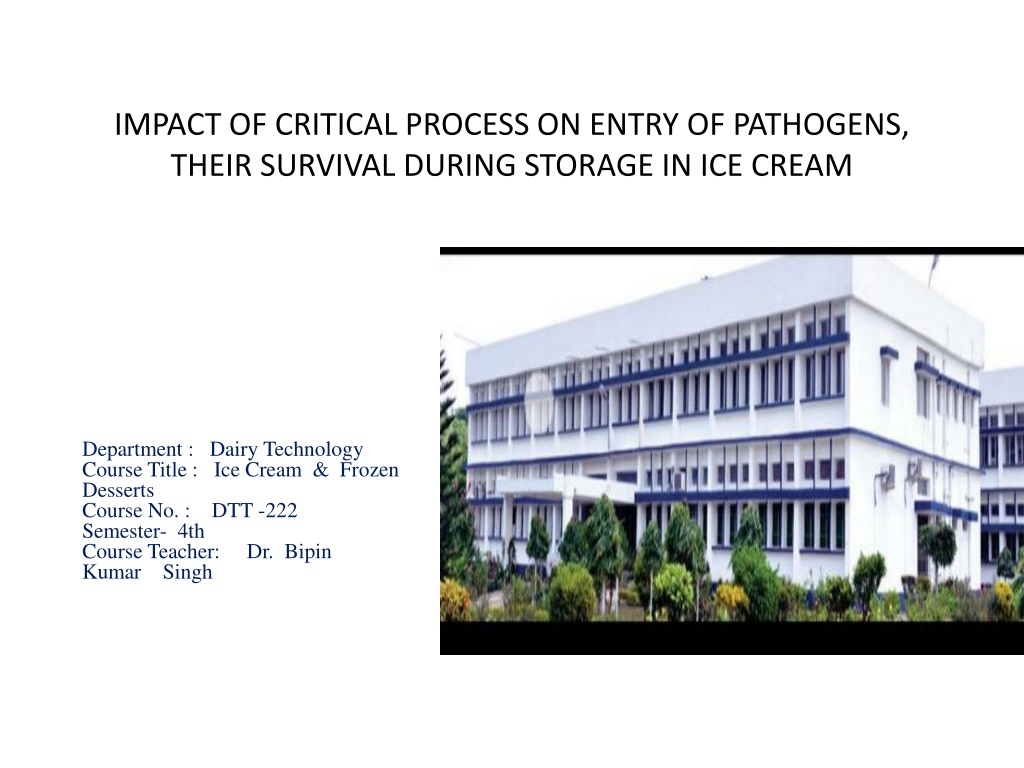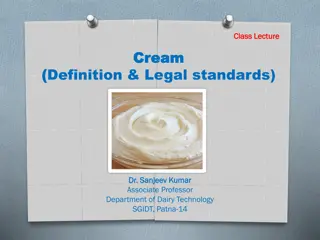Impact of Critical Process on Pathogen Entry and Survival in Ice Cream Manufacturing
The critical processes in ice cream manufacturing, such as pasteurization, homogenization, and chilling, play a crucial role in reducing pathogens and microorganisms, ensuring product safety. Pasteurization at specific temperatures and times effectively eliminates pathogenic organisms, while homogenization can lead to recontamination if not managed properly. Proper sterilization of equipment like coolers is essential to prevent contamination. Understanding these factors is vital for ensuring the microbiological quality and safety of ice cream products.
Download Presentation

Please find below an Image/Link to download the presentation.
The content on the website is provided AS IS for your information and personal use only. It may not be sold, licensed, or shared on other websites without obtaining consent from the author. Download presentation by click this link. If you encounter any issues during the download, it is possible that the publisher has removed the file from their server.
E N D
Presentation Transcript
IMPACT OF CRITICAL PROCESS ON ENTRY OF PATHOGENS, THEIR SURVIVAL DURING STORAGE IN ICE CREAM Department : Dairy Technology Course Title : Ice Cream & Frozen Desserts Course No. : DTT -222 Semester- 4th Course Teacher: Dr. Bipin Kumar Singh
Introduction Some of the critical process factors in the manufacture of ice cream will certainly affect the extent of killing of Pathogens and Microorganisms. Some of the critical process factors in the manufacture of pasteurization, homogenization, ageing, freezing and hardening. ice cream include chilling,
Pasteurization Pasteurization is one of the main steps that determine the microbiological quality of the finished product. The extent to which pasteurization will reduce the bacterial count depends upon the heating temperature, holding time and the type of organisms present. Fortunately pathogenic organisms are destroyed at a relatively low heat treatment. Bacteriologists agree that the tuberculosis) show the highest heat resistance of those that come into consideration in milk and dairy products; and it has been destroyed at 60 C for 20 minutes of heat treatment. The usual pasteurization temperature of 62.8 C for 30 minutes applied to ice cream mixes therefore allows a generous margin of safety with suspect to all pathogenic organisms that may be present. Pasteurization in excess of 62.8 C for30 minutes is helpful in eliminating E. Coli and Aerobacteraerogenes. tubercle bacilli (Mycobacterium
Homogenization The opportunities for recontamination are considerably greater in the case of ice cream mixes than in the case of pasteurized market milk. The pasteurized ice cream mix comes into contact with more pieces of equipment, and some of this equipment is admittedly difficult to sterilize. Two factors are involved in producing an increase in the bacterial count of ice cream mixes on homogenization
Contd.. Contamination from the homogenizer The breaking up of the group s of bacterial cells. A study revealed that the average plate count before and after homogenization of ice cream mix were 14,500 and 49,236 respectively which has accounted for an increase of 239.5%.
Chilling/Coolers Coolers may act as an important source of contamination if they are carelessly washed and sterilized. Surface coolers should be sterilized by pumping water at 82.2 to 87.8 C over them in ample amounts so that the entire surface is actually heated. Chemical chlorine at 100 ppm level is advocated. Tubular coolers can also be sterilized with hot water. Chemical sterilization is frequently used and it should be done just before the equipment is used. sterilization with
Ageing If ageing conditions are moderately good, there will be little increase in the bacterial count of the mix. It is well known that the growth of bacteria is very slow at the temperatures commonly used in ageing ice cream mixes. The ageing procedure should therefore be undertaken only if accompanied by a program of efficient sterilization of equipment.
Freezing and Hardening An increase in the plate colony count which is commonly observed when the mix is frozen into ice cream involves two factors a. Breaking up of group of cells b. Actual contamination from the freezer.























